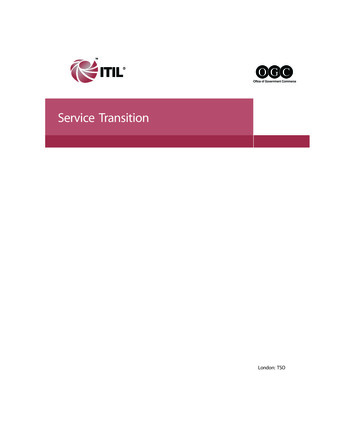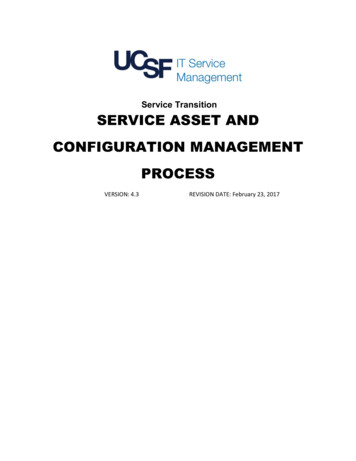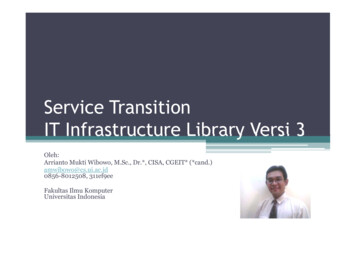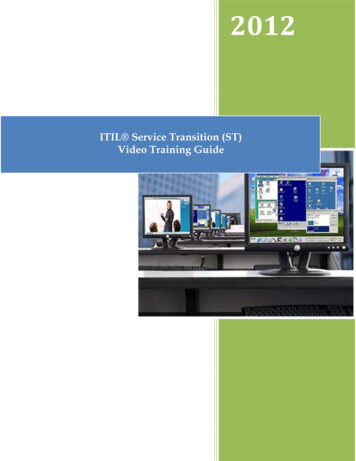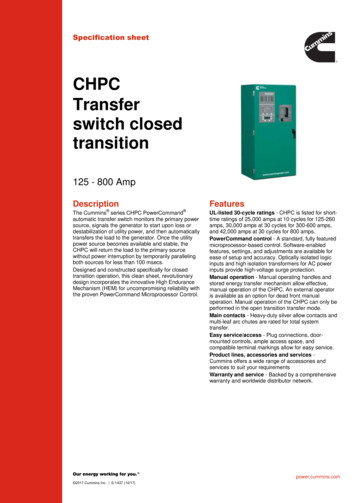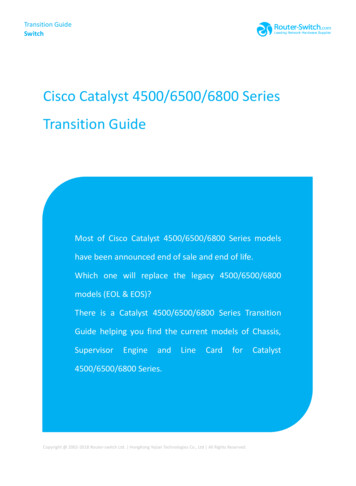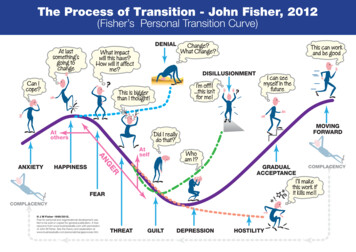
Transcription
The Process of Transition - John Fisher, 2012(Fisher’s Personal Transition Curve)DENIALAt lastsomething’sgoing tochangeWhat impactwill this have?How will it affectme?Can Icope?This can workand be goodDISILLUSIONMENTI’m off!!.this isn’tfor me!This is biggerthan I thought!AtothersI can seemyself in thefutureMOVINGFORWARDDid I reallydo that?AtselfRGEANANXIETYChange?What Change?HAPPINESSWhoam I?GRADUALACCEPTANCEI’ll makethis work ifit kills me!!FEARCOMPLACENCY J M Fisher 1999/2012.Free for personal and organizational development use.Not to be sold or copied for general publication. A freeresource from www.businessballs.com with permissionof John M Fisher. See the theory and explanation OMPLACENCYTHREATGUILTDEPRESSIONHOSTILITY
john fisher's personal transition curve - 2012 - thestagesanxietyThe awareness that events lie outside one's range of understanding or control. I believethe problem here is that individuals are unable to adequately picture the future. Theydo not have enough information to allow them to anticipate behaving in a different waywithin the new organisation. They are unsure how to adequately construe acting in thenew work and social situations. There is also the possibility for what McCoy (1977)defined as 'bewilderment' here; which she defined as an awareness of an imminent,comprehensive change in our non-core structure. How we then deal with this dictateshow we progress through the rest of the curve and the extent of the impact on our coresense of self.happinessThe awareness that one’s viewpoint is recognised and shared by others. The impact ofthis is twofold. At the basic level there is a feeling of relief that something is going tochange and not continue as before. Whether the past is perceived positively ornegatively, there is still a feeling of anticipation and possibly excitement at thepossibility of improvement. On another level, there is the satisfaction of knowing thatsome of your thoughts about the old system were correct (generally no matter how wellwe like the status quo there is something that is unsatisfactory about it) and thatsomething is going to be done about. In the phase we generally expect the best andanticipate a bright future, placing our own construct system onto the change andseeing ourselves succeeding. One of the dangers in this phase is that of theinappropriate psychological contract. We may perceive more to the change, or believewe will get more from the change than is actually the case. The organisation needs tomanage this phase and ensure unrealistic expectations are managed and redefined inthe organisations terms without alienating the individual.The happiness phase is one of the more interesting phases and may be (almost) passedthrough without knowing. In this phase it is the 'Thank Goodness, something ishappening at last!' feeling coupled with the knowledge that we may be able to have animpact, or take control, of our destiny and that if we are lucky/involved/contributethings can only get better. If we can start interventions at this stage we can minimisethe impact of the rest of the curve and virtually flatten the curve. By involving,informing, getting 'buy in' at this time we can help people move through the process.
fearthe awareness of an imminent incidental change in one's core behavioural system.People will need to act in a different manner and this will have an impact on both theirself-perception and on how others externally see them. However, in the main, they seelittle change in their normal interactions and believe they will be operating in much thesame way, merely choosing a more appropriate, but new, action.According to Frances (1999), Fear and Threat are the two key emotions that will causeus to resist change.threatthe awareness of an imminent comprehensive change in one's core behaviouralstructures. Here people perceive a major change on what they believe to be their coreidentity or sense of self. The realisation that change that will have a fundamentalimpact on who we are, how we see ourselves and what is key in our personality to usas individuals. This is the shock of suddenly discovering you're not who you thoughtyou were! It is a radical alteration to our future choices and other people's perception ofthem as individuals. Their old choices are no longer ones that will work. In many waysthis is 'road to Damascus' type of life-changing experience, one that has the potential to'shake you to the core!'. In this phase, people are unsure as to how they will be able toact/react in what is, potentially, a totally new and alien environment - one where the'old rules' no longer apply and there are no 'new' ones established as yet.guiltAn awareness of a dislodgement of our self from our core self perception. We are notwho we thought we were! Once the individual begins exploring their self-perception,how they acted/reacted in the past and looking at alternative interpretations they beginto re-define their sense of self. This, generally, involves identifying what are their corebeliefs and how closely they have been to meeting them. Recognition of theinappropriateness of their previous actions and the implications for them as people cancause guilt as they realise the impact of their behaviour. Another of the emotions thatmay have an impact here is that of 'Shame', in Kellyian terms this is the awareness of anegative change in someone else's opinion of you from what you think it should be. Therecognition of this shift in our own and other peoples opinion then leads into the nextstage.depressionThe awareness that our past actions, behaviours and beliefs are incompatible with ourcore construct of our identity. The belief that our past actions mean we're not a very
nice person after all! This phase is characterised by a general lack of motivation andconfusion. Individuals are uncertain as to what the future holds and how they can fitinto the future 'world'. Their representations are inappropriate and the resultantundermining of their core sense of self leaves them adrift with no sense of identity andno clear vision of how to operate.gradual acceptanceHere we begin to make sense of our environment and of our place within the change.In effect we are beginning to get some validation of our thoughts and actions and cansee that where we are going is right. We are at the start of managing our control overthe change, make sense of the 'what' and 'why' and seeing some successes in how weinteract - there is 'a light at the end of the tunnel!' This links in with an increasing levelof Self-confidence, which in Kellyian terms is defined as an awareness of the goodnessof fit of the self in one's core role structure - i.e., we feel good that we are doing theright things in the right way.moving forwardIn this stage we are starting to exert more control, make more things happen in apositive sense and are getting our sense of self back. We know who we are again andare starting to feel comfortable that we are acting in line with our convictions, beliefs,etc. and making the right choices. In this phase we are, again, experimenting within ourenvironment more actively and effectively.disillusionmentThe awareness that your values, beliefs and goals are incompatible with those of theorganisation. The pitfalls associated with this phase are that the employee becomesunmotivated, unfocused and increasingly dissatisfied and gradually withdraws theirlabour, either mentally (by just 'going through the motions', doing the bare minimum,actively undermining the change by criticising/complaining) or physically by resigning.From personal experience I can say I've left a company where I found myself becomingincreasingly disillusioned with them. My values and theirs were no longer matched and Ifelt the gulf too big to accommodate whilst still staying true to my construct system.hostilityThe continued effort to validate social predictions that have already proved to be afailure. The problem here is that individual's continue to operate processes that haverepeatedly failed to achieve a successful outcome and are no longer part of the newprocess or are surplus to the new way of working. The new processes are ignored atbest and actively undermined at worst.
denialThis stage is defined by a lack of acceptance of any change and denies that there willbe any impact on the individual. People keep acting as if the change has not happened,using old practices and processes and ignoring evidence or information contrary to theirbelief systems. In many ways when we are faced with a problem, or situation, we don'twant, or one that we believe is too challenging to our sense of self we 'constrict' ornarrow our range of construction. In this way we eliminate the problem from ourawareness. The 'head in the sand' syndrome - if I can't see it, or acknowledge it then itdoesn't exist!angerI have come to recognise over time that there seems to be some anger associated withmoving through the transition curve, especially in the earlier stages as we start torecognise the wider implications of change. This is not always present as it seems to bedepending on the amount of control people feel they have over the overall process andthe focus of the anger changes over time. In the first instance, for those where changeis 'forced' on them, the anger appears to be directed outward at other people. They are'blamed' for the situation and for causing stress to the individual etc. However, as timeprogresses and the implications grow greater for the individual the anger movesinwards and there is a danger that this drives us into the 'Guilt' and 'Depression' stages.We become angry at ourselves for not knowing better and/or allowing the situation toescalate outside our control.complacencyIt has also been suggested that there is also actually a final (initial stage?) ofComplacency (King 2007). Here people have survived the change, rationalised theevents, incorporated them into their new construct system and got used to the newreality. This is where we feel that we have, once again, moved into our 'comfort zone'and that we will not encounter any event that is either outside our construct system (orworld view) or that we can't incorporate into it with ease. We know the right decisionsand can predict future events with a high degree of certainty. They are subsequentlylaid back, not really interested in what's going on around them and coasting throughthe job almost oblivious to what is actually happening around them. They are, again,operating well within their comfort zone and in some respects can't see what all thefuss has been about. Even though the process may have been quite traumatic for themat the time!
so what?. (a brief summary of the 2012 transitiontheory)It can be seen from the transition curve that it is important for an individual tounderstand the impact that the change will have on their own personal constructsystems; and for them to be able to work through the implications for their selfperception. Any change, no matter how small, has the potential to impact on anindividual and may generate conflict between existing values and beliefs and anticipatedaltered ones.To help people move through the transition effectively we need to understand theirperception of the past, present and future. What is their past experience of change andhow has it impacted on them?, how did they cope? Also what will they be losing as partof the change and what will they be gaining?Therefore the goal of the 'manager'/change agent is to help make the transition aseffective and painless as possible. By providing education, information, support, etc. wecan help people transition through the curve and emerge on the other side.One of the dangers for individuals is that once we are caught up in the emotion of thechange we may miss the signs (e.g., of threat, anxiety, etc) in ourselves and others.This could cause us to react by, or adopt a coping strategy of, complaining to anyonewho will listen, and probably anyone who won't! Or we attempt to make things as theywere (which also increase our stress levels as a result) and actively resist any attemptsto change us.I would argue that we transit through all stages (although the old caveat of some ofthese stages may be extremely quickly traversed and not consciously recognisableapplies). In the main we will progress through all the phases in a linear or sequentialway (although we may move in either direction as circumstances change throughout.Each stage builds on the last stage and incorporates any learning (positive andnegative) from our experience.So we can see that our perception of the situation could be escalating in 'severity' ofimpact and importance to our sense of self as we go through the phases. We descendinto the trough of depression via a small impact on our sense of self (anxiety), speed upthrough a greater realisation of impact and meaning (fear, threat) and then comes therealisation that (potentially) our core sense of self has been impacted and our 'selfbelief system' undermined to a large extent (guilt, depression) which contradicts whowe thought we were.Now if someone is going through multiple transitions at the same time; these couldhave a cumulative impact on them as individuals. As people could being going throughall the different transitions almost simultaneously - it then becomes a case of more andmore 'evidence' all of which is supporting previous negative a rapidly dropping self
confidence and increasingly negative self image which just compounds the problem. Weend up similar to the 'frozen rabbit in the headlights not knowing which way to turn'!.As with any personal transformation, there are no clear boundaries to any of thesestages. It is more of a gradual realisation that things have subtly changed. On apersonal note my mother had a major stroke some years ago that has left herincapacitated down one side; over the succeeding years I've noticed that ourbenchmark of how we see her has gradually lowered over time - the 'highs' are lowerand the good days less good - but, as in many walks of life, they become the newnorm.With your teams, it is more a case of helping people through the process as effectivelyas possible. Also as each person will experience transition through the curve at slightlydifferent speeds (and, as I mentioned earlier, we may be at different places on differentcurves - depending on just what is happening to us at the time).Much of the speed of transition will depend on the individual's self perception, locus ofcontrol, and other past experiences, and how these all combine to create theiranticipation of future events. The more positive you see the outcome, the more controlyou have (or believe you have) over both the process and the final result the lessdifficult and negative a journey you have.John Fisher, Process of Personal Transition, 2012.
(a brief summary of the 2012 transition theory) It can be seen from the transition curve that it is important for an individual to understand the impact that the change will have on their own personal construct systems; and for them t



